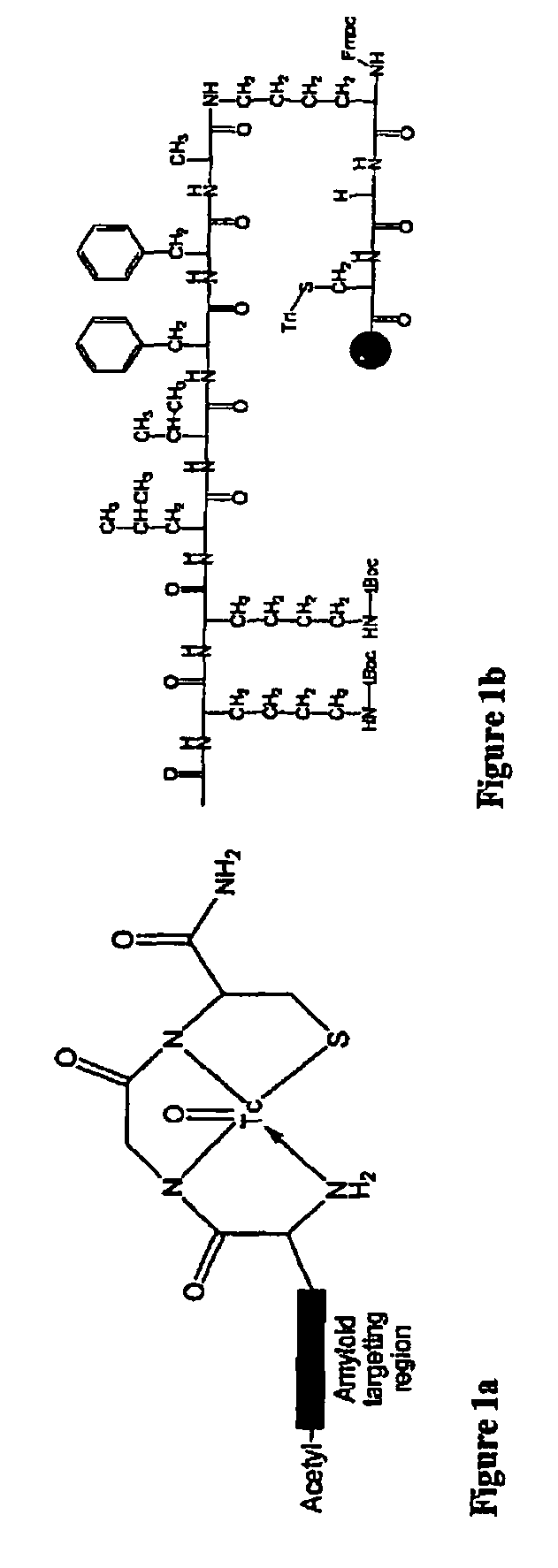Blood brain barrier permeation peptides
a blood brain barrier and peptide technology, applied in the direction of peptides, peptide sources, therapies, etc., can solve the problems of inability to permeate the intact blood brain barrier, significant limitations of known imaging agents, and significant challenges in the design of peptide metal chelates which can report on the functional status or biological activity of targets in the central nervous system
- Summary
- Abstract
- Description
- Claims
- Application Information
AI Technical Summary
Benefits of technology
Problems solved by technology
Method used
Image
Examples
example 1
Synthesis of Permeation Peptides
[0175]BBB permeation peptides were synthesized based on short peptides incorporating the sequence KLVFF that were known to bind to Aβ (Tjernberg et al., 1997). A D-permeation probe was designed in part using the sequence KLVFF, and by using three functional constituents: a) an amyloid targeted-peptide sequence; b) a linker moiety; and c) a peptide-based chelation core for incorporation of technetium-99m for medical imaging (FIG. 1a). A peptide having the final overall amino acid sequence KKLVFFAεKGC (SEQ. ID. NO.: 1) was prepared by coupling the amino acids using solid-phase peptide synthesis (SSPS) using L- or D-N-α-FMOC-protected amino acid residues and standard coupling techniques as described in more detail supra.
[0176]The peptide was purified on a semi-preparative C-18 column (Xterra) using Water's HPLC system equipped with dual A detector (2487) set to 214 and 280 nm. The fraction eluting at Rt=13.6 min was collected, lyophilized, and analyzed t...
example 2
HPLC Characterization of Peptides
[0177]For characterization, RP-HPLC was performed, the requisite fractions isolated and their identities confirmed through electron spray mass spectrometry (FIG. 2). Both peaks (Rt=12.4; 12.8 min) with Re-peptide demonstrated identical mass [ESMS: calcd for C57H89N14O12ReS: 1380.6; Found: 1381 (Rt=12.4 min; peak A); 1381 (Rt=12.8 min; peak B)]. Thus, the peaks represented the existence of two isomers of the N3S chelation moiety in relation to the metal-oxygen bond, due to participation of the chiral α-C atom of lysine in the chelating ring. The formation of the two anticipated diastereoisomers (the apical oxygen being syn and anti relative to the side chain of lysine residue) were consistent with metals in both conjugates, 99mTc-peptide or Re-peptides, using an identical chelation core.
example 3
In Vivo Characterization
[0178]To confirm stability under in vivo conditions, the peptide was radiolabeled with technetium-99m through a ligand exchange procedure using 99mTc-glucoheptonate and the desired fraction separated through Radio-RP-HPLC. The 99mTc-labeled peptide was incubated in human serum at 37° C. for 3 h. Thereafter, Radio-TLC analysis using a radiometric detection system (Bioscans 2000) was performed to evaluate the presence of metabolites in the mixture. The 99mTc-peptide demonstrated persistence of the parental peptide only, thereby indicating stable incorporation of the radio-metal within the chelation core (FIG. 3).
PUM
| Property | Measurement | Unit |
|---|---|---|
| time | aaaaa | aaaaa |
| pH | aaaaa | aaaaa |
| energy | aaaaa | aaaaa |
Abstract
Description
Claims
Application Information
 Login to View More
Login to View More - R&D
- Intellectual Property
- Life Sciences
- Materials
- Tech Scout
- Unparalleled Data Quality
- Higher Quality Content
- 60% Fewer Hallucinations
Browse by: Latest US Patents, China's latest patents, Technical Efficacy Thesaurus, Application Domain, Technology Topic, Popular Technical Reports.
© 2025 PatSnap. All rights reserved.Legal|Privacy policy|Modern Slavery Act Transparency Statement|Sitemap|About US| Contact US: help@patsnap.com



